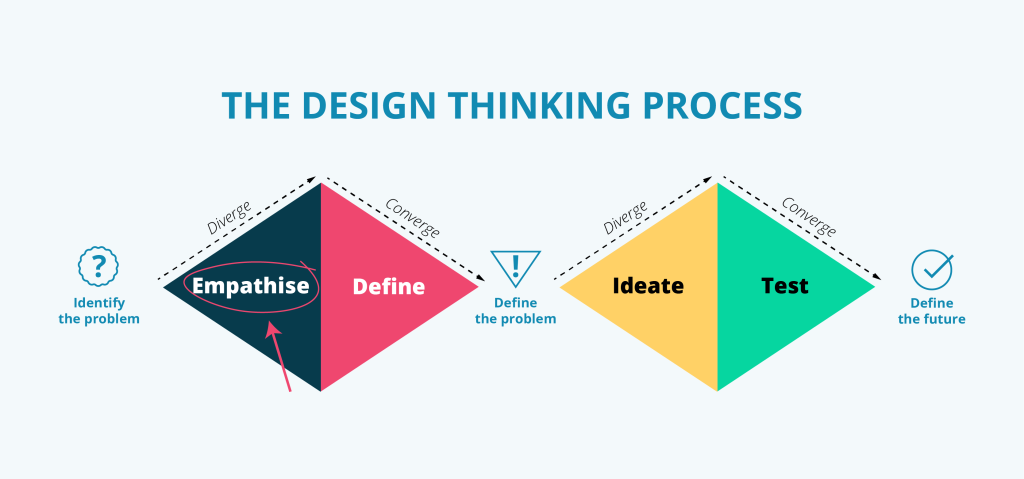
Over the past number of years, empathy has taken centre stage in the Customer Experience (CX) space. It has become a crucial tool for businesses to help understand their customers more deeply, particularly their motivations and feelings.
What is Empathy & Why Does it Matter?
Empathy, by definition, is the ability to understand and share the feelings of others. It’s not about asking customers what they want, but rather understanding their behaviour and feelings.

The above quote highlights the limitations of traditional customer feedback and emphasises the need for a more profound, empathetic understanding of customer needs.
Empathy in CX is about moving beyond the numbers and statistics of quantitative research. While quantitative methods have their place, they are best used in conjunction with an empathetic approach that uncovers the underlying human emotions that drive decision-making. This is where empathetic customer research stands out—it focuses on understanding what people have done in the past, why they did it, and how they felt during the process.
The Role of Empathy in Design Thinking
Empathy is a foundational element of the design thinking process, particularly in the “double diamond” model.

This model is a framework for creative problem-solving, where the first phase—empathise—involves discovering and exploring the true nature of a problem. Often, businesses and clients enter this phase with a preconceived notion of what the problem might be. However, through empathetic research, the problem can be reframed, leading to more innovative and effective solutions.
Design thinking, with empathy at its core, is not a one-size-fits-all solution. Instead, it works alongside other forms of thinking – critical and structured thinking – to tackle complex problems.
Empathetic Research vs. Traditional Market Research
Traditional market research typically focuses on gathering specific, quantifiable data, often through surveys and questionnaires. While this method can provide valuable insights, it tends to be reductionist, focusing on averages and broad trends rather than individual experiences and emotions.
In contrast, empathetic research is divergent—it explores a wide range of experiences, motivations, and feelings. Instead of asking, “What do you want?” it delves into “Why do you feel this way?” and “What experiences have shaped your behaviour?”. This approach uncovers deeper insights into customer behaviour, allowing businesses to design experiences that resonate on an emotional level.
To illustrate the power of empathy in customer experience, let’s look at two contrasting case studies: one in the childcare sector and another involving the U.S. Air Force.
Childcare Provider Case Study
A childcare organisation in Australia wanted to understand what families valued most and why. By conducting empathetic research with 14 families across New South Wales, the organisation was able to identify key behaviours, needs, and emotional drivers.
This research led to the creation of behavioural personas, which were then used to design a customer journey map that included customer emotional states at every stage in enrolling their child. The journey map revealed that families often feel anxious about waiting lists and the unpredictability of availability.
Having this information allowed the organisation to put structures and solutions in place to ease the anxiety and improve the overall customer experience.
The US Air Force Case Study: A Lesson in Empathy
During the 1940s, the US Air Force faced a perplexing and tragic problem: an average of 17 aviation crashes per day. The situation was dire, and the blame was placed on everyone from pilots to engineers. Pilots were labelled incompetent, and engineers were criticised for designing overly complex planes. Despite numerous investigations, the root cause of these accidents remained a mystery.
It wasn’t until the Air Force shifted their focus to the cockpit design that the true issue was uncovered. The cockpits had been designed based on the “average” soldier’s body, using extensive data to create a standard layout. However, this approach overlooked the individual differences in pilots’ body sizes and how they interacted with the cockpit in real-world scenarios.
Through empathetic research, which involved directly engaging with pilots and observing how they navigated the cockpit, the Air Force discovered that the one-size-fits-all design was fundamentally flawed. The famous quote below encapsulates the lesson learned brilliantly:

As a result of this empathetic approach, the Air Force radically changed its design philosophy. They moved away from focusing on averages and instead began to prioritise the needs of individual pilots, incorporating adjustable equipment to accommodate different body sizes and improving overall safety.
This approach highlights the power of empathy in solving complex problems. By understanding the unique needs of individuals rather than relying on generalised data, the Air Force was able to implement changes that had a profound impact on both safety and performance.
Applying Empathy in CX: Techniques and Tools
In the world of CX, empathy plays a vital role in journey mapping and profiling. These techniques are essential for understanding the customer’s perspective and designing experiences that truly meet their needs.
In practical terms, empathy can be applied through techniques like contextual inquiry—a method of conducting research in the environment where customers live, work, and make decisions. Today this is even easier as you can harness the power of video conferencing tools that have proven effective for conducting empathetic research remotely.
One effective tool for incorporating empathy into CX is the use of customer personas. These personas are developed based on qualitative research, including interviews and observations, to represent different segments of the customer base.
By understanding the specific needs, behaviours, and pain points of these personas, businesses can design journeys that are tailored to meet the emotional and functional needs of their customers.
Another crucial aspect of empathetic CX design is the use of journey maps. These maps outline the steps a customer takes throughout their interaction with a product or service, highlighting both the rational and emotional aspects of their experience. By mapping out the customer’s journey, businesses can identify key pain points and opportunities for improvement, ensuring that the final design is both functional and emotionally resonant.
Customer journey mapping toolkit: Enrol in our Professional Diploma in CX today and get access to multiple toolkits with which you’ll design and deliver successful CX Strategies.
Incorporating empathy into CX is not just about addressing surface-level issues; it’s about understanding the deeper emotional drivers that influence customer behaviour.
In conclusion, empathy is more than just a buzzword in customer experience. It is a powerful approach that can transform the way businesses interact with customers. Whether it’s through design thinking, contextual inquiry, or the development of behavioural personas, empathy provides the insights needed to create products, services, and experiences that truly resonate. By taking the time to understand the individual needs and emotions of customers, businesses can design experiences that are not only effective but also deeply meaningful.
When you enrol in our Professional Diploma in CX you’ll successfully deliver CX strategies that are based on deep emotional bonds.